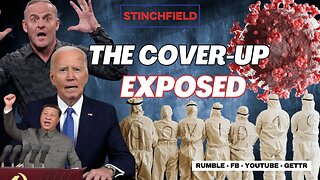Premium Only Content

Typical Food Service Establishment Inspection-Part 1
A typical food service establishment inspection involves a thorough evaluation of various aspects of food safety, hygiene, and operational practices to ensure that the restaurant or food service facility is in compliance with health and safety regulations. Here’s Part 1 of a typical inspection breakdown, focusing on the initial steps and key areas that inspectors will evaluate during the visit.
---
### **1. Preparation for the Inspection**
Before the actual inspection begins, inspectors may gather information on the food service establishment from previous records or complaints. This allows them to tailor their inspection approach based on the facility's history or any known concerns.
- **Review Previous Reports**: Inspectors will check the history of previous inspections, violations, and whether they were resolved.
- **Inspection Scope**: The inspector will confirm the scope of the inspection, which could be routine or triggered by a complaint, a foodborne illness outbreak, or a follow-up to previous issues.
---
### **2. Initial Walkthrough and Establishment Overview**
Upon arrival, inspectors typically begin with an **initial walkthrough** of the food service establishment to get an overall sense of its layout and cleanliness. This allows them to identify any immediately visible issues or hazards.
- **Exterior Conditions**: Inspectors may begin by observing the exterior of the restaurant, including the parking lot, trash disposal area, and any possible pest problems (e.g., rodent activity).
- **Entrance and Accessibility**: Check the cleanliness and safety of the entrance. The door should be properly functioning, and the restaurant should be free from pests in public areas.
- **Employee Behavior**: Inspectors will observe staff during this walkthrough, ensuring they are wearing appropriate uniforms, gloves, and handling food properly.
---
### **3. Reviewing Food Storage and Refrigeration**
The **storage of food** is one of the most important areas that inspectors focus on during an inspection. They will check if food is being stored safely to prevent contamination or spoilage.
#### **a. Cold Storage (Refrigerators and Freezers)**
Inspectors will evaluate:
- **Temperature Control**: Check if refrigerators are operating at the correct temperature (usually **below 5°C/41°F**) and freezers are at **-18°C/0°F**. Temperature logs are often reviewed to confirm consistent operation.
- **Food Separation**: Ensure that **raw foods (meat, seafood, poultry)** are stored separately from **ready-to-eat foods** (e.g., salads, cooked foods) to avoid cross-contamination. This is typically done in separate containers or on different shelves.
- **Proper Labeling**: Inspectors check if food is properly labeled with **storage dates** (expiration, use-by, or preparation dates). This helps avoid using spoiled or unsafe food.
#### **b. Dry and Shelf Storage**
Inspectors will verify:
- **Shelf Organization**: Food must be stored at least **6 inches off the floor** to prevent contamination from dirt or pests.
- **Pest Protection**: Inspectors look for signs of **pests** in food storage areas, such as droppings or nests.
- **Proper Packaging**: Dry foods should be kept in **sealed, pest-proof containers**, and open food items should be covered.
---
### **4. Checking Food Handling and Preparation Areas**
Once the storage areas are evaluated, the inspector moves on to assessing how food is being handled and prepared. This includes:
#### **a. Hand Washing Stations**
Inspectors check for:
- **Accessible and Functional Hand Washing Stations**: These should be stocked with **soap, warm water, and paper towels**. Handwashing is required before handling food, after using the restroom, or after handling raw food.
- **Proper Signage**: Signs reminding employees to wash hands must be visible in bathrooms and near food prep areas.
- **Hand Sanitizer**: If used, **hand sanitizer** should not replace handwashing but can be an additional measure for hygiene.
#### **b. Food Prep Surfaces and Equipment**
Inspectors check:
- **Cleanliness of Surfaces**: All food prep areas (counters, cutting boards) should be **clean, sanitized, and free of debris**.
- **Cross-Contamination Prevention**: Ensure that staff are using **different cutting boards and utensils** for raw meats and ready-to-eat foods to avoid cross-contamination. **Color-coded cutting boards** may be used.
- **Sanitation of Equipment**: Inspectors check whether equipment like knives, mixers, and blenders are being properly cleaned and sanitized after each use.
#### **c. Cooking Temperature Checks**
- Inspectors will check whether food is cooked to the **correct internal temperature** to kill harmful bacteria (e.g., poultry should reach 165°F, ground beef should be 160°F).
- **Food Thermometers**: Inspectors may review the calibration and condition of **food thermometers** to ensure they are working properly and being used regularly.
---
### **5. Observing Employee Practices**
Inspectors pay close attention to how employees are handling food during the inspection. Key areas include:
- **Proper Food Handling**: Employees should be using **gloves**, **tongs**, or **utensils** to handle ready-to-eat foods. They should avoid touching food with bare hands, especially in areas where customers can see.
- **Food Safety Knowledge**: Inspectors may ask employees about food safety protocols, such as how they handle raw meat, how long food is stored in the fridge, and how they prevent cross-contamination.
- **Employee Health**: Inspectors will check whether employees are wearing **appropriate uniforms** and **not showing symptoms of illness** (e.g., coughing, vomiting). There should also be procedures for staff to report if they are ill.
---
### **6. Cleaning and Sanitation Practices**
Inspectors will evaluate whether cleaning procedures are being followed consistently, which is critical for food safety.
- **Sanitizing of Surfaces and Equipment**: After every food prep session, surfaces and equipment should be **sanitized** using the proper chemicals and methods.
- **Dishwashing**: Inspectors check whether dishwashing is done in a **three-compartment sink**, with the proper steps: washing, rinsing, and sanitizing. They will verify if dishwashers are in good working order.
- **Restroom Hygiene**: Inspectors will check the cleanliness of restrooms, ensuring they are stocked with **soap and paper towels** for handwashing and are being regularly cleaned.
---
### **Conclusion of Part 1 of the Inspection**
At this stage, the health inspector will have a good overview of the restaurant's cleanliness, food handling, and storage practices. If issues are found, the inspector will typically record them and may issue a **report of violations**. The restaurant will be given a chance to correct these issues before a follow-up inspection occurs.
In the next part of the inspection, the inspector will dive deeper into any critical violations, review documentation (e.g., temperature logs), and issue recommendations or mandates for improvement.
Would you like to explore Part 2, which typically involves a more in-depth review of specific violations, enforcement actions, or how restaurants can prepare for an inspection?
-
 3:31
3:31
SLS - Street League Skateboarding
1 day agoCoco Yoshizawa’s 3rd Place Finish at SLS Tokyo 2024 | Best Tricks
16.9K2 -
 46:15
46:15
Grant Stinchfield
21 hours ago $4.32 earnedNew: The COVID Cover-up Revealed! Team Biden Caught in a Big Lie!
15.4K5 -
 LIVE
LIVE
The Shannon Joy Show
16 hours ago🔥🔥LIVE Exclusive W/Daniel Horowitz - New Year 2025 Analysis On Culture, Economy & Politics🔥🔥
958 watching -
 33:14
33:14
Tudor Dixon
2 hours agoThe World Walk with Tom Turcich | The Tudor Dixon Podcast
10.5K -
 7:29:48
7:29:48
PudgeTV
8 hours ago🔴 Gaming on Rumble - Marvel Rivals | Iron Man's Armory: Equipping Groot and Jeff for Battle
19.3K2 -
 1:58:48
1:58:48
The Charlie Kirk Show
2 hours ago2024 In Review + The Truth About H-1Bs | Girdusky, Carl | 12.30.24
61.3K19 -
 6:51
6:51
The Rubin Report
3 hours agoDave Rubin Reacts to Trump’s Greatest Moments
29.5K4 -
 DVR
DVR
Bannons War Room
1 year agoWarRoom Live
102M -
 0:57
0:57
Steven Crowder
4 hours agoCROWDER CLASSICS: AOC & the Lion’s Den (Bible Story Parody)
89.6K8 -
 50:00
50:00
Graham Allen
7 hours agoGoodbye 2024…. HELLO 2025!!
72.3K17